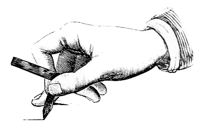1854 Unified Knickerbocker-Eagle-Gotham Rules
In November 1853 the Eagle Club sent a letter to the Knickerbockers, asking for guidance in the rules of the game. The result was a three-way conference the following spring at Smith's Tavern between representatives of the Eagles, Knicks and Gothams, where they agreed upon a joint set of rules for all three clubs. It will be seen that in most respects they duplicate those Knickerbocker Rules applicable to game-play, but with two key additions: the first ever specification of the pitching distance in Rule 1, and the first rule governing the size and weight of the ball in Rule 17.
Adopted April 1, 1854
1st. The bases shall be from “Home” to second base, forty-two paces; and from first to third base, forty-two paces, equidistant; and from Home to pitcher not less than fifteen paces.
2nd. The game to consist of twenty-one counts or aces; but at the conclusion an equal number of hands must be played.
3rd. The ball must be pitched, and not thrown, for the bat.
4th. A ball knocked outside the range of the first or third base, is foul.
5th. Three balls being struck at and missed, and the last one caught, is a hand out; if not caught is considered fair, and the striker bound to run.
6th. A ball being struck, or tipped, and caught, either flying or on the first bound, is a hand out.
7th. A player must make his first base after striking a fair ball, but should the ball be in the hands of an adversary on the first base before the runner reaches that base, it is a hand out.
8th. Players must make the bases in the order of striking, and when a fair ball is struck and the striker not put out, the first base must be vacated as well as the next base or bases if similarly occupied; players may be put out, under these circumstances, in the same manner as when running to the first base.
9th. A player shall be out, if at any time when off a base he shall be touched by the ball in the hands of an adversary.
10th. A player who shall intentionally prevent an adversary from catching or getting the ball, is a hand out.
11th. If two hands are already out, a player running home at the time a ball is struck, cannot make an ace if the striker is caught out.
12th. Three hands out, all out.
13th. Players must take their strike in regular rotation; and after the first inning is played the turn commences at the player who stands on the list next to the one who lost the third hand.
14th. No ace or base can be made on a foul strike.
15th. A runner cannot be put out in making one base, when a balk is made by pitcher.
16th. But one base allowed if the ball, when struck, bounds out of the field.
17th. The ball shall weigh from five and a half to six ounces, and be from two and three-quarters to three and a half inches in diameter.
